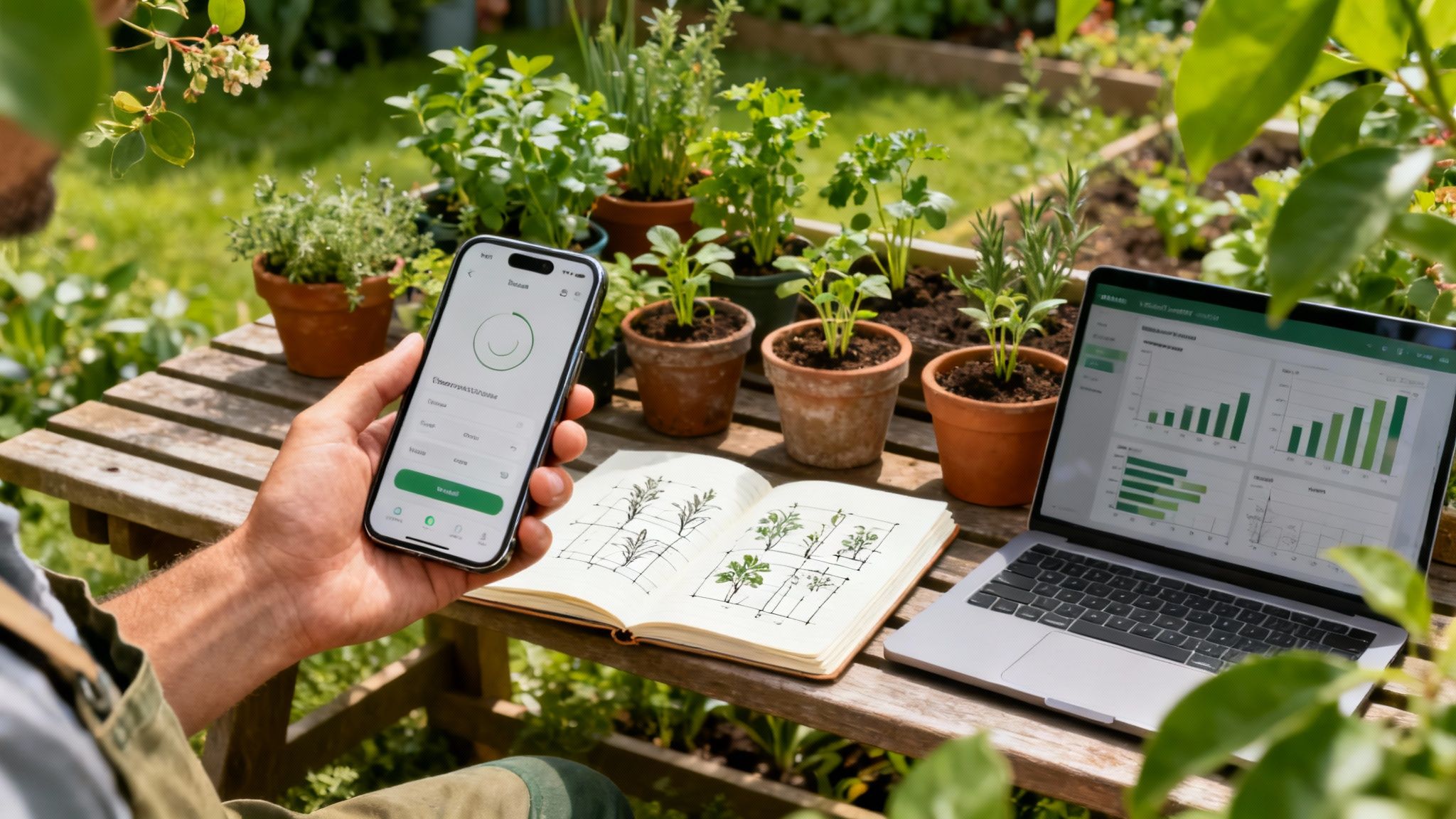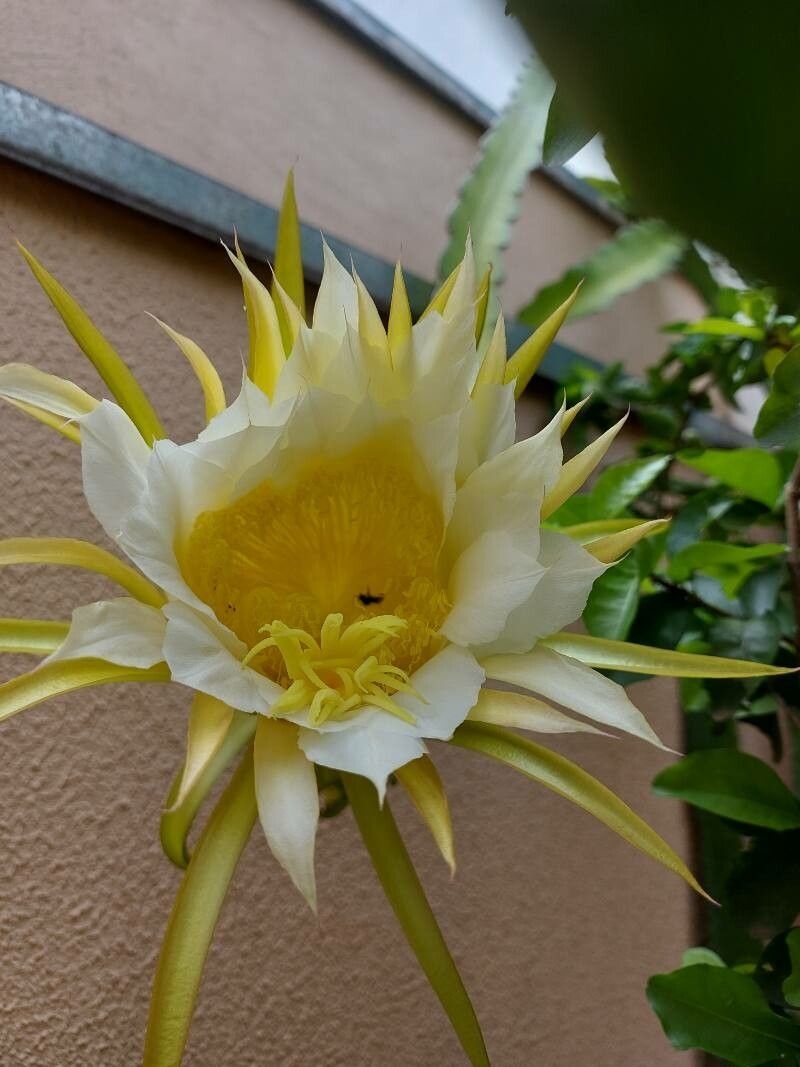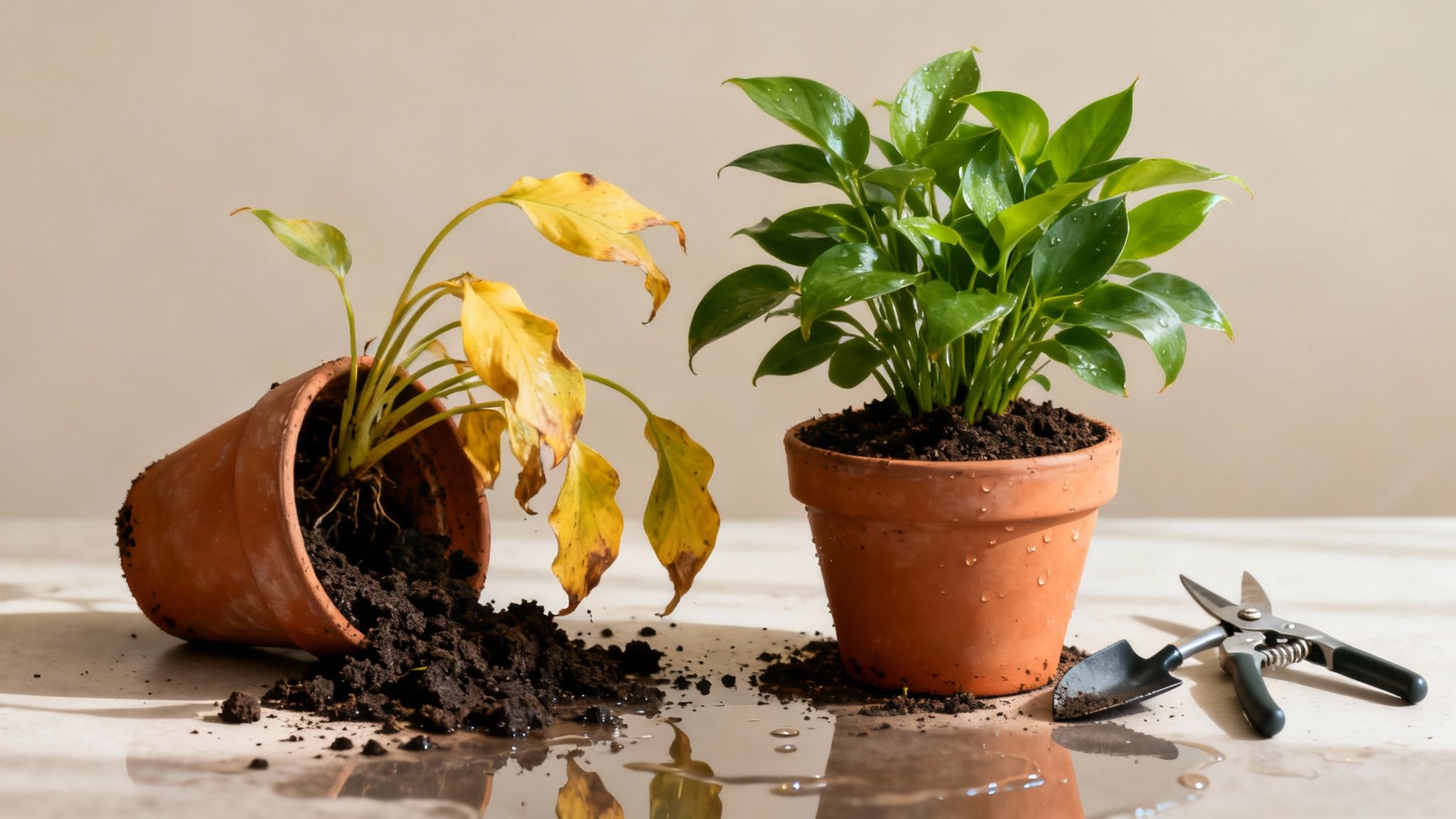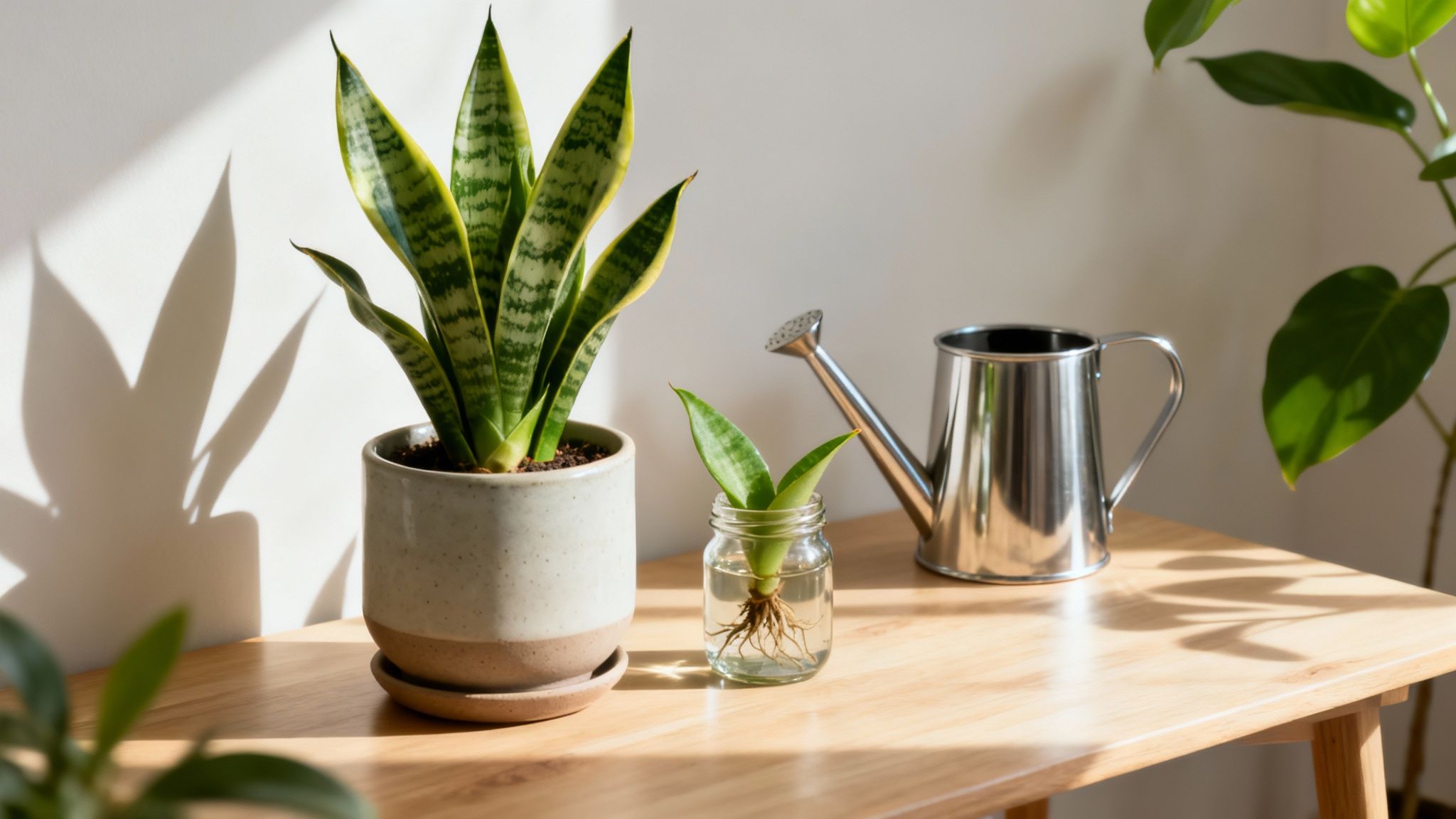Ever found yourself staring at a mysterious plant, wondering if it's a weed or a wildflower? Or perhaps you've forgotten the last time you watered your beloved fiddle-leaf fig (Ficus lyrata)? You're not alone. In fact, a recent survey revealed that over 40% of new gardeners struggle with inconsistent watering. Luckily, your smartphone can be your most powerful gardening tool, transforming frustrating guesswork into confident, joyful growing. The right app can identify a botanical mystery in seconds, remind you exactly when to feed your tomatoes, and even connect you with fellow gardeners in your neighborhood.
This guide cuts through the noise to deliver a practical review of the best free gardening apps available. We’ve meticulously tested each platform to give you an honest look at its true capabilities. Forget generic feature lists; we're diving deep into real-world scenarios, from identifying a rare avocado cultivar to planning your entire vegetable patch for maximum yield. You'll get an inside look at the most accurate AI plant identifiers, robust garden planners, and vibrant community platforms designed to help you connect, grow, and share.
Whether you’re nurturing a few houseplants on a windowsill or managing a small orchard, this list is designed to help you select the perfect digital tool to help your garden thrive. Get ready to transform your thumb from brown to green.
1. Tendra by Gaialab
For gardeners seeking a powerful, data-driven companion, Tendra by Gaialab emerges as a premier choice. This platform distinguishes itself by integrating sophisticated AI technology with an unparalleled depth of specialized horticultural information, making it one of the best free gardening apps available for both novices and seasoned experts. It moves far beyond basic identification, offering a comprehensive ecosystem to solve specific problems like disease diagnosis and finding climate-specific plant varieties.
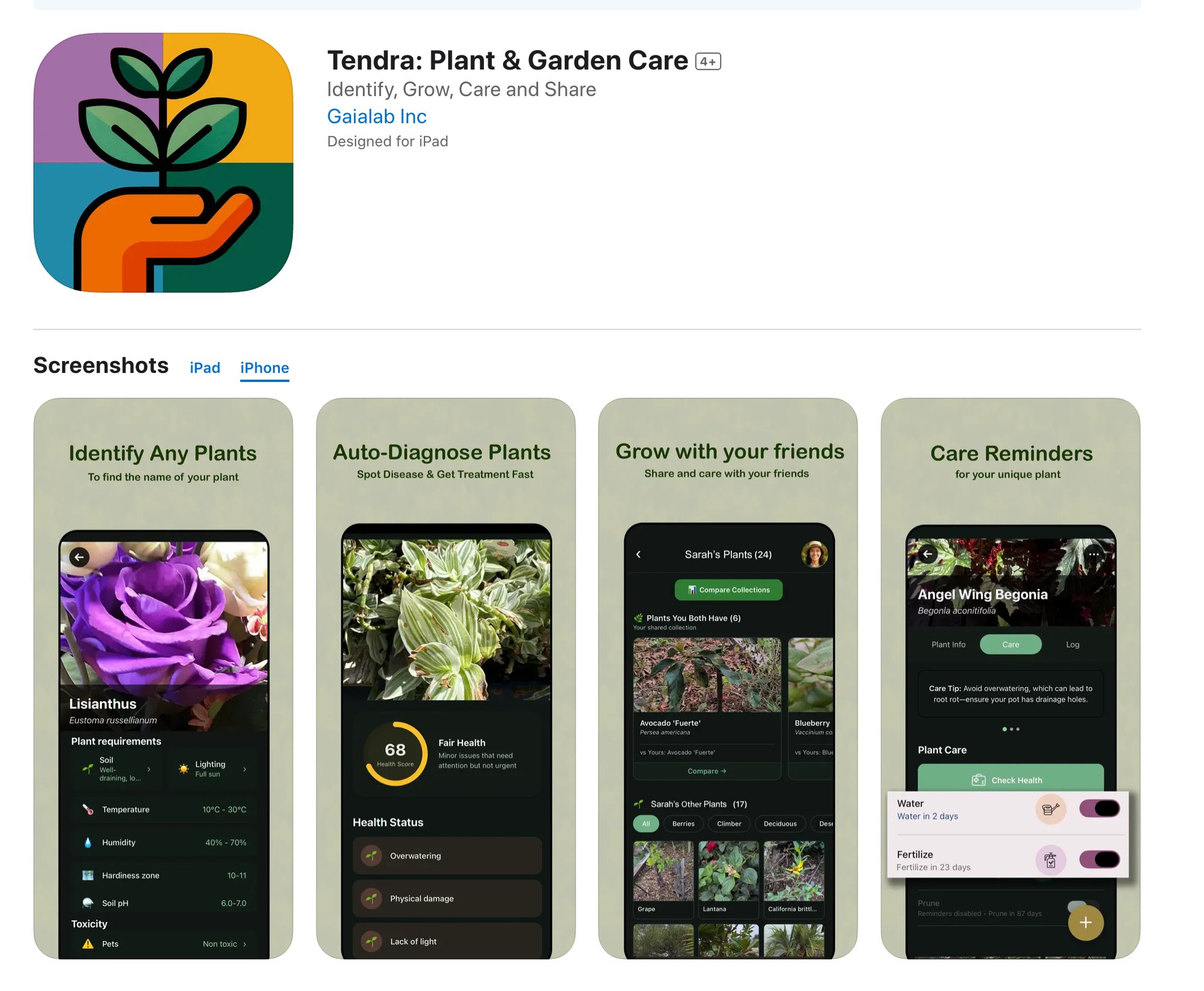
The platform’s core strength lies in its dual AI models, which deliver plant identification with over 99% accuracy in seconds. This is complemented by an instant AI disease diagnosis feature that provides actionable, IPM-based treatment plans from a single photo, empowering you to protect your plants proactively.
However, Tendra's true standout feature is its Cultivar Explorer. While other apps identify common species, Tendra provides meticulously detailed databases for specific fruit cultivars. For instance, it features over 140 varieties of dragon fruit (Hylocereus undatus) and extensive entries for avocados (Persea americana), citrus, mangoes, figs and a lot more. This granular data, including Brix scores (sweetness), pollination needs, and flavor profiles, is an invaluable resource for serious growers aiming to optimize their harvests.
Key Features & Use Cases
AI Plant & Disease Identification: Quickly identify an unknown plant in your yard or diagnose a concerning leaf spot on your cherished houseplant. The high accuracy ensures you can take immediate and correct action.
Comprehensive Cultivar Databases: If you're choosing among five citrus varieties for your USDA zone, Tendra provides the detailed data necessary to compare cold hardiness, fruit size, and oil content.
Smart Care Reminders: The app creates personalized schedules for watering, fertilizing, and pruning each plant in your garden. Gamified streak rewards encourage consistent care habits.
Twin Plant Mates™: This feature connects you with local gardeners cultivating the same plant varieties. It offers practical climate-specific advice or opportunities to trade rare cuttings.
Garden Management: Organize and oversee your entire garden efficiently, ensuring optimal growth and health for all your plants.
The entire app, including identification and diagnosis features, operates on a freemium model, supported by watching ads and referrals. All databases and information, including cultivar details and community connections, are available without charge.
Website: https://tendra-app.com
Download App 👉 https://app.adjust.com/1twh6tqr
2. iNaturalist
While not designed exclusively for garden planning, iNaturalist is an indispensable tool for any gardener and firmly earns its spot as one of the best free gardening apps available. Its primary function is plant and wildlife identification, powered by a unique combination of artificial intelligence and a massive global community of scientists and naturalists. For a gardener, this means you can finally identify that mysterious "weed" that keeps popping up or figure out what kind of beneficial insect just landed on your tomatoes.
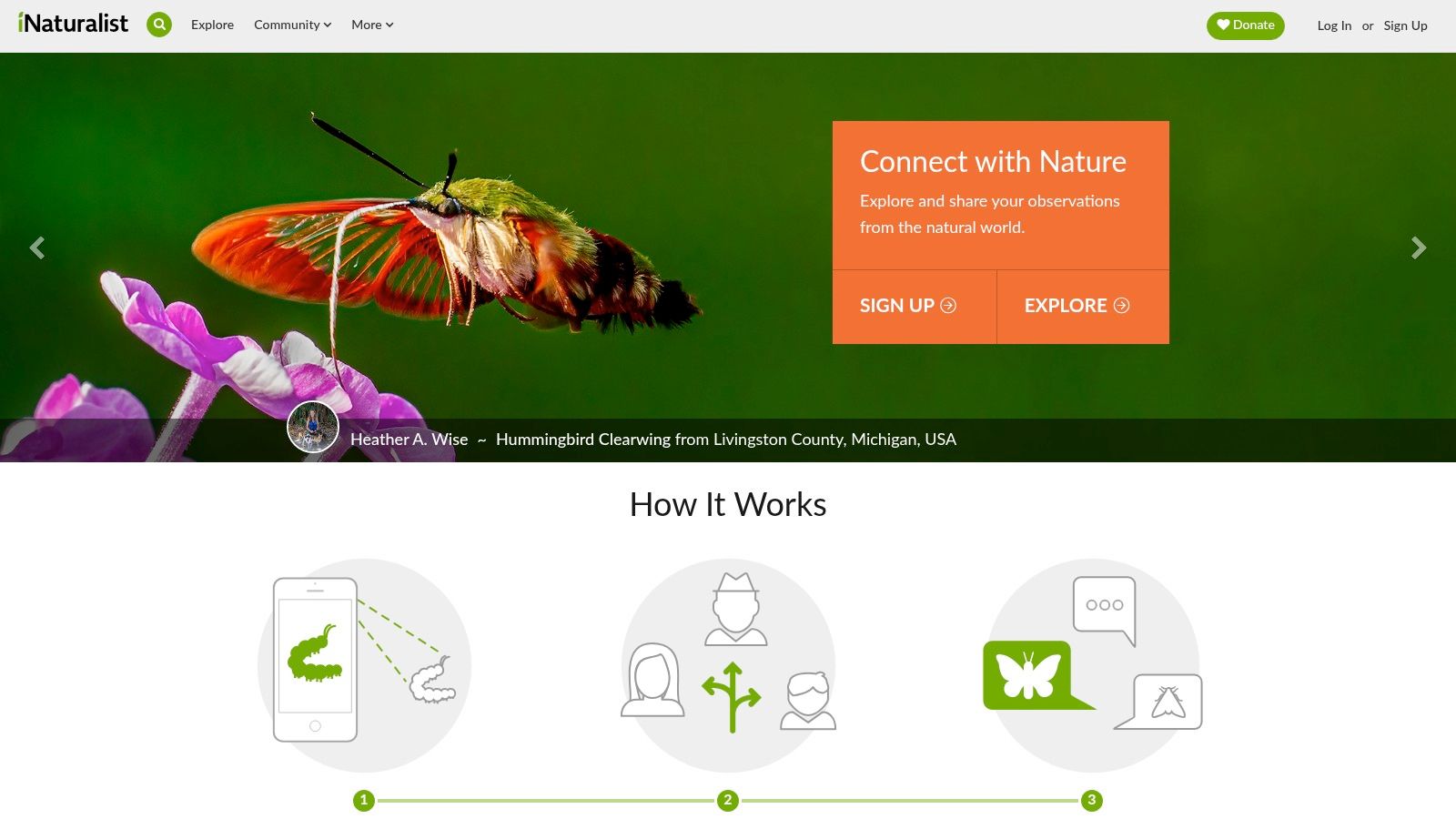
The process is simple: you snap a few clear photos of a plant, upload it as an "observation," and the app's AI suggests possible identifications. Then, the community weighs in to confirm or correct the ID, providing a level of accuracy that purely AI-driven apps sometimes lack. This citizen-science approach is what makes iNaturalist so powerful. Did you know that observations from iNaturalist have contributed to hundreds of scientific papers? Every plant you log contributes to real biodiversity data used by researchers worldwide.
Why It Stands Out
What makes iNaturalist special is its non-profit, ad-free model and its focus on scientific accuracy through community consensus. It excels at identifying wild or "volunteer" plants that commercial apps might miss.
Practical Use Case: You notice an unfamiliar vine choking your prized rose bush. Is it a native, beneficial plant or an invasive species like bindweed (Convolvulus arvensis)? You can upload a photo to iNaturalist, and within hours, experienced users can help you identify it, allowing you to take appropriate action.
Best For: Gardeners focused on native plants, permaculture, identifying unknown weeds, and learning about local biodiversity.
Pros: Completely free with no ads or subscriptions, community verification adds a layer of confidence, and your usage contributes to scientific research.
Cons: Not a garden management tool; it won't track your watering schedules or bed layouts. Identification quality depends heavily on the clarity of your photos.
Access: https://www.inaturalist.org
3. Seek by iNaturalist
A perfect companion to the more robust iNaturalist platform, Seek is designed for instant gratification and family-friendly exploration. It functions as a "Shazam for nature," using your phone's camera to provide immediate, on-the-spot identification of plants and animals without needing an account. For you, this means a quick, private way to identify a new flower at the nursery or teach children about the different species in your backyard.
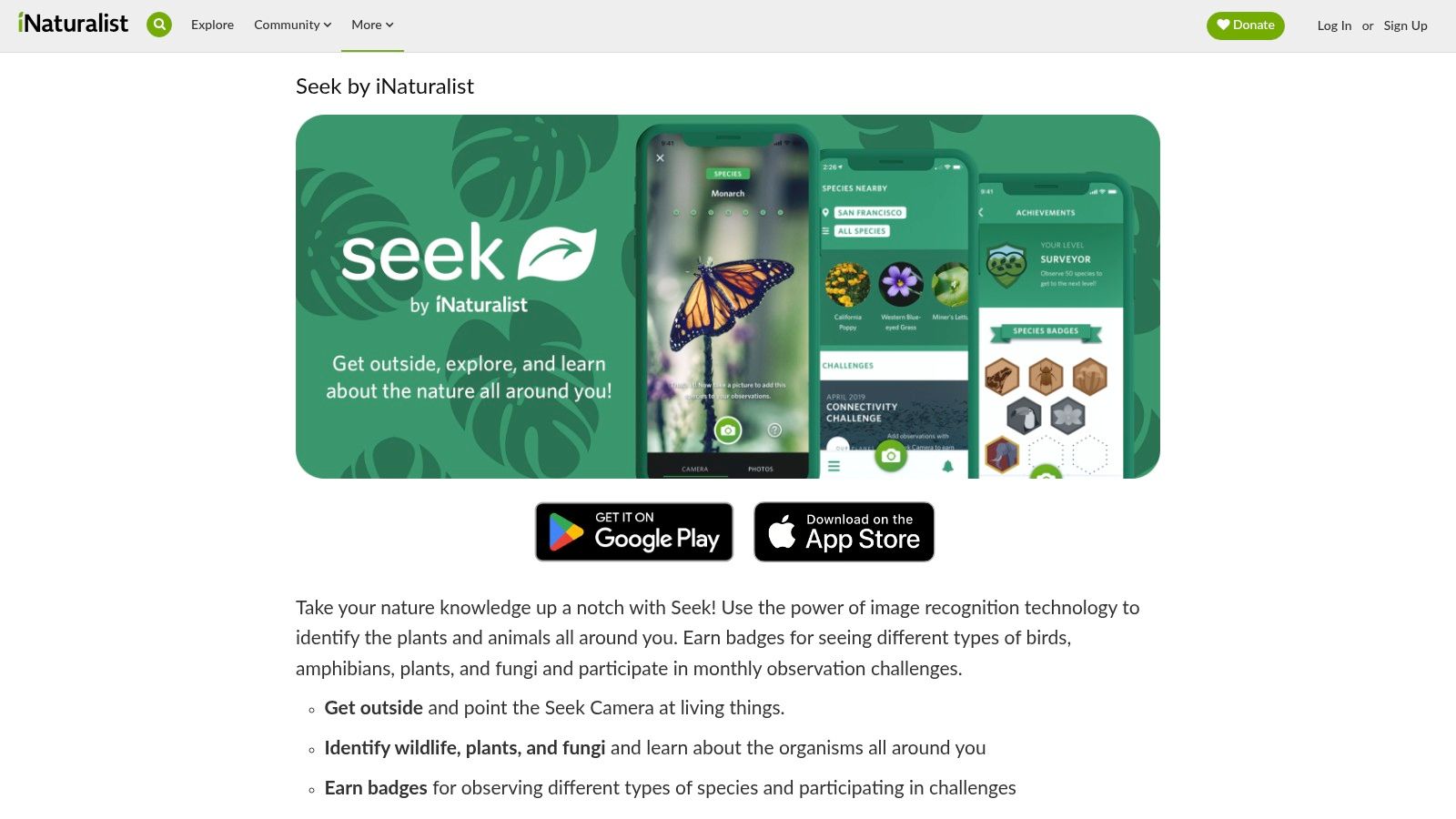
The app's interface is incredibly simple: point your camera at a plant, and the AI works in real-time to suggest a species, often down to the genus level. Once identified, you can learn more about it through a linked Wikipedia article. Seek also includes fun challenges and badges to encourage discovery, making it an engaging educational tool for aspiring young gardeners.
Why It Stands Out
Seek's main advantage is its absolute simplicity and focus on privacy. Unlike other identification apps, it requires no sign-up and no data logging. Everything happens on your device, making it one of the best free gardening apps for casual users or parents who want a safe, ad-free experience for their kids.
Practical Use Case: You're on a walk with your children and they spot a vibrant wildflower you don't recognize. Instead of a lengthy search, you can use Seek to identify it instantly as a Common Poppy (Papaver rhoeas), turning a simple walk into an interactive learning moment about local flora.
Best For: Gardeners needing quick, private identifications, families with children, and anyone who wants a straightforward "point and identify" tool without social features.
Pros: Completely free with zero ads, extremely easy to use, and excellent for privacy since no account is needed.
Cons: Lacks garden management tools and the community verification feature of the main iNaturalist app.
Access: https://www.inaturalist.org/seek
4. Pl@ntNet
Pl@ntNet operates as a powerful citizen-science project focused on plant identification, making it another essential resource on our list of best free gardening apps. Like iNaturalist, its core strength is identifying plants from photos, but it specializes in providing suggestions based on different parts of the plant. You can submit images of a flower, leaf, bark, or fruit, and the AI will use that specific visual data to narrow down potential matches—a feature that is incredibly helpful when a plant isn't in full bloom.

The platform is a collaborative effort involving scientists from several French research organizations, and every identification you submit helps expand its massive and growing database. While its roots are in identifying wild flora, its database has grown to include many ornamental and cultivated plants, making it increasingly useful for the average home gardener trying to identify a gifted plant or a volunteer seedling.
Why It Stands Out
What distinguishes Pl@ntNet is its multi-organ identification capability. The ability to submit a picture of just a leaf or a piece of bark and still get a reliable ID is a game-changer. This makes it a versatile tool for year-round identification, not just during the flowering season.
Practical Use Case: Your neighbor gives you a cutting from a beautiful shrub, but neither of you knows its name. The cutting has no flowers. You can take clear photos of the leaves and stem, upload them to Pl@ntNet, and get a strong identification, allowing you to research its specific care needs, such as sun exposure and soil type.
Best For: Gardeners needing to identify plants from specific parts (leaf, bark, fruit), those who prefer a desktop interface, and anyone interested in both wild and cultivated plant identification.
Pros: Completely free with no ads, strong accuracy that improves with multiple photos of different plant parts, and a useful web version for desktop analysis.
Cons: Lacks any garden management tools like watering schedules or layout planners. Its database is more focused on wild species than on specific cultivated varieties.
Access: https://identify.plantnet.org
5. From Seed to Spoon
For gardeners focused on growing their own food, From Seed to Spoon is a highly practical and user-friendly tool that easily qualifies as one of the best free gardening apps. It is specifically designed as an edible garden planner for the US, providing personalized planting dates based on your GPS location, guidance on identifying common pests, and a straightforward visual bed planner.

The app simplifies the most challenging aspects of vegetable gardening, like timing and placement. After you enter your location, it calculates the best dates to sow seeds indoors or outdoors and estimates harvest times. Its visual layout planner helps you implement companion planting strategies to naturally deter pests and improve growth. The addition of an AI 'Growbot' provides quick answers to common gardening questions, making it an excellent resource for troubleshooting in the field.
Why It Stands Out
What makes From Seed to Spoon exceptional is its singular focus on edible gardening, combined with hyper-local planting data. Unlike general-purpose apps, every feature is tailored to help you successfully grow vegetables, fruits, and herbs. Its beginner-friendly interface and extensive video tutorials remove much of the guesswork for new gardeners.
Practical Use Case: You live in USDA Zone 7b and want to start a fall garden but are unsure what to plant or when. You can input your location into From Seed to Spoon, and the app will generate a list of suitable fall crops like broccoli (Brassica oleracea) and kale (Brassica oleracea var. acephala), providing precise dates for when to plant them for a successful autumn harvest.
Best For: Vegetable and herb gardeners in the US, beginners seeking step-by-step guidance, and anyone interested in companion planting.
Pros: The core app is free and highly functional; perfectly suited for edible gardens, with beginner-friendly workflows and educational content.
Cons: Primarily focuses on edibles, offering limited features for ornamental plants. Some advanced features are behind a subscription.
Access: https://www.seedtospoon.net
6. Planter: Garden Planner
For those who swear by the efficiency of square-foot gardening, Planter is an elegant and highly focused tool that easily ranks as one of the best free gardening apps for bed design. Its core strength lies in its intuitive, drag-and-drop interface that simplifies the often-complex task of laying out a vegetable garden. It visually represents how many plants, like carrots or lettuces, you can fit into a single square foot, taking the guesswork out of spacing.
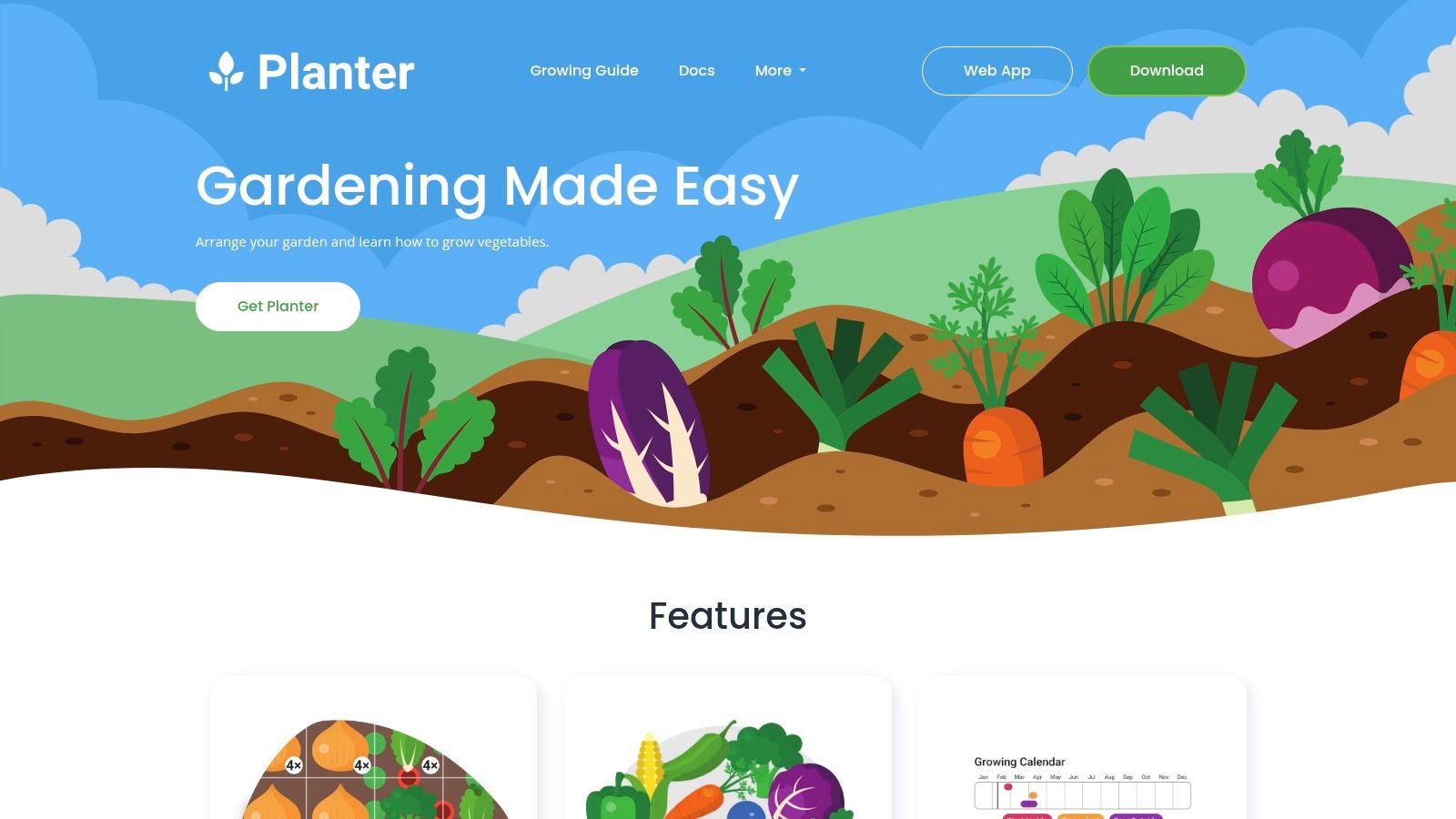
The app comes pre-loaded with over 80 common edible plants and provides specific timing for sowing, planting, and harvesting based on your USDA Hardiness Zone. This feature is a game-changer for new gardeners who might be unsure of their local planting windows. The platform also includes helpful companion planting information, visually indicating which plants are friends and which are foes right on your layout grid.
Why It Stands Out
Planter’s laser focus on square-foot garden planning for edibles makes it uniquely powerful for that specific purpose. Unlike broader apps, its interface is not cluttered with features for ornamental or perennial gardens. The companion planting indicators are exceptionally clear, using simple color-coding to guide your layout decisions for better growth and pest management.
Practical Use Case: You have a 4x8-foot (1.2x2.4 m) raised bed and want to maximize your harvest. Using Planter, you can drag and drop tomatoes, basil, and carrots into your grid. The app automatically shows you the correct spacing for each and alerts you that tomatoes and basil are beneficial companions, encouraging you to place them near each other for improved flavor and health.
Best For: Vegetable gardeners, especially beginners and those using raised beds or the square-foot gardening method.
Pros: Excellent free tier allows one full garden layout, clear visual guides for spacing and companion planting, and Zone-specific planting calendars.
Cons: Primarily designed for annual edibles; not ideal for ornamental or perennial garden design. Unlimited gardens and advanced features require a paid subscription.
Access: https://planter.garden
7. Gardenize
Gardenize operates as a comprehensive digital garden journal, allowing you to meticulously track your plants, garden areas, and activities. It functions like a sophisticated diary for your green space, making it a powerful contender among the best free gardening apps for those who love organization. You can create entries for individual plants, document events with photos, and organize your garden into distinct areas like "Front Yard Flower Bed" or "Vegetable Patch."
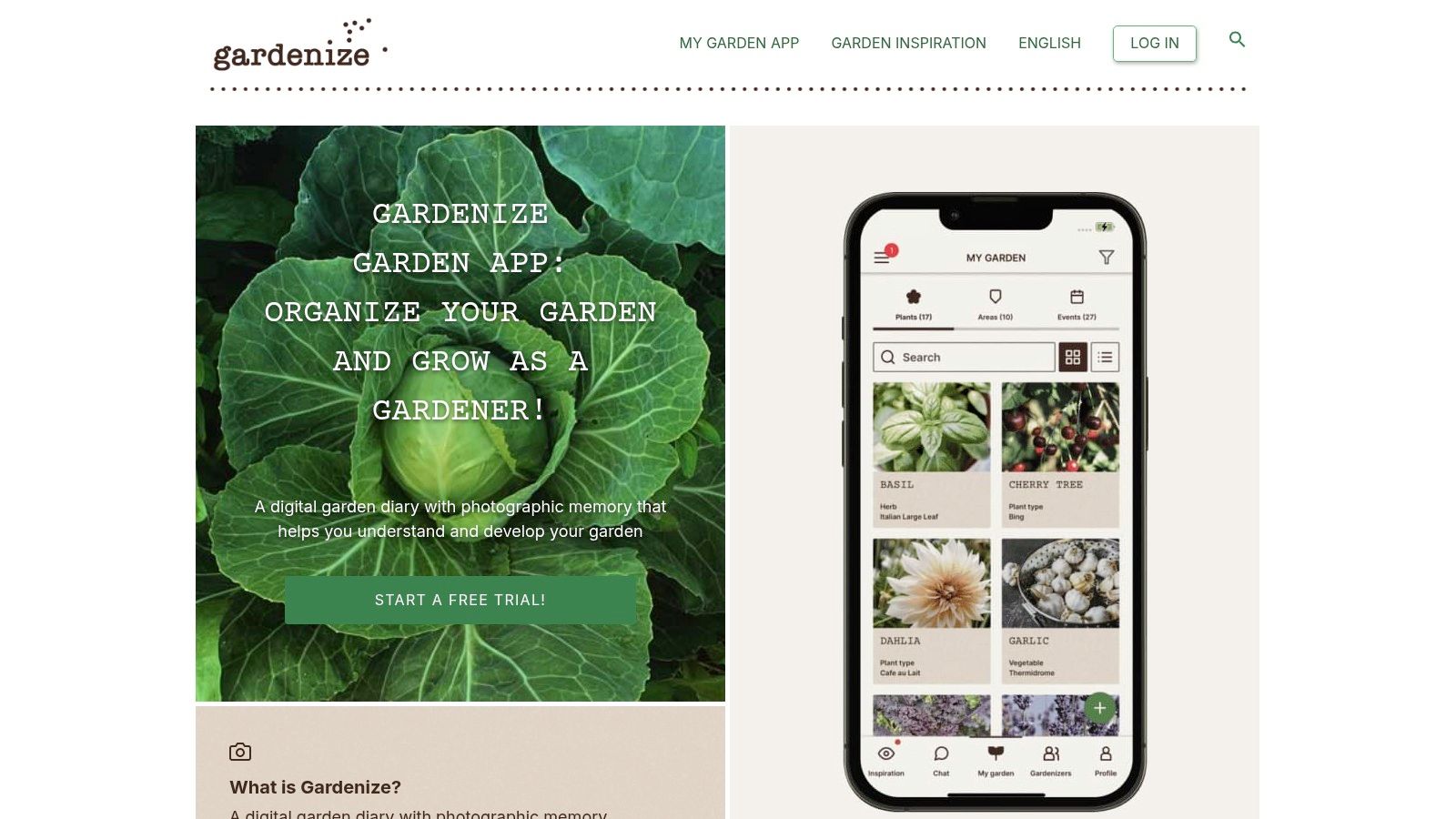
The app's strength lies in its ability to build a detailed, searchable history of your garden. Each plant can have its own profile with photos, notes on watering, and logs of key events like pruning or first blooms. The free version offers robust journaling capabilities, a plant database, and the ability to set reminders, which is more than enough for many home gardeners to get started and stay organized throughout the seasons.
Why It Stands Out
What separates Gardenize is its journal-first approach. Instead of focusing on garden layout planning, it excels at creating a rich, chronological record of your plants and their progress. The built-in community feed also provides inspiration by showing you what other gardeners are doing, creating a more social and less isolating experience.
Practical Use Case: You have over 30 different perennials, herbs, and annuals in various beds. With Gardenize, you can create a profile for each one. When you fertilize your lavender (Lavandula angustifolia), you can log the date, type of fertilizer, and add a photo, ensuring you have a perfect record to reference next year to replicate your success.
Best For: Gardeners with diverse, multi-bed gardens who want to keep a detailed historical record of their plants' health and activities.
Pros: Excellent for organizing large plant collections, creates a searchable history of your garden, and includes an inspirational community feed.
Cons: Many advanced features like data export and drawing tools are locked behind the paid "Plus" subscription. It is less focused on initial vegetable bed layout than dedicated planner apps.
Access: https://gardenize.com
8. Garden Answers
For those moments of immediate garden panic, Garden Answers serves as a quick and simple diagnostic tool, securing its place as one of the best free gardening apps for on-the-spot problem-solving. Its core function is rapid plant identification using your phone's camera. You simply take a photo, and the app's recognition technology instantly suggests what the plant might be, along with basic information about it.
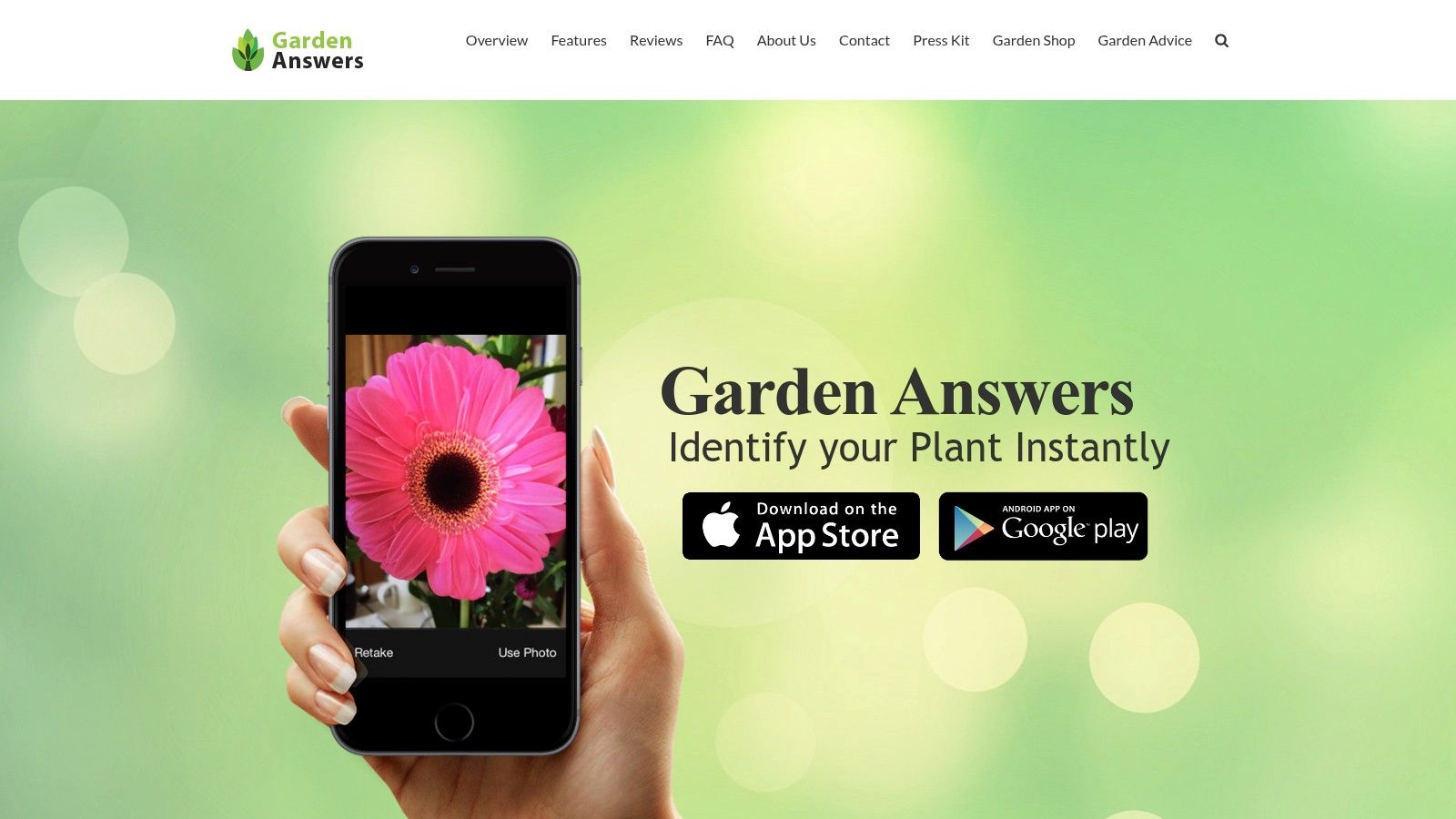
Beyond simple identification, the app contains a large, searchable database of previously answered questions related to pests, diseases, and general plant care. This allows you to find solutions to common issues without having to post a new query. While the core identification and database search are free, the app offers a premium "Ask a Horticulturist" feature for a small fee, connecting you with an expert for personalized advice on tougher challenges.
Why It Stands Out
Garden Answers excels at providing immediate, straightforward answers. Its interface is clean and focused, prioritizing speed and ease of use over complex garden management features. This makes it an excellent first-stop app for new gardeners who need a quick ID or a fast answer to a common pest problem without getting overwhelmed.
Practical Use Case: You find strange spots on your zucchini leaves and aren't sure if it’s a nutrient deficiency or a disease like powdery mildew. You can snap a photo for identification and then use the app's Q&A database to search for "spots on zucchini leaves." You'll likely find photos and advice from others who have faced the exact same issue, guiding your next steps.
Best For: Beginners needing rapid plant identification and solutions to common garden ailments.
Pros: Very easy to use for instant plant ID, extensive free Q&A database for troubleshooting, and provides basic care information quickly.
Cons: Lacks any garden planning or management tools, and personalized expert help comes at a cost.
Access: https://www.gardenanswers.com
9. PictureThis
PictureThis is one of the most popular and polished plant identification apps on the market, functioning as a slick, all-in-one digital botanist. While it operates on a freemium model, its free features provide significant value, making it a strong contender among the best free gardening apps. Its core function is rapid, AI-driven plant and disease identification from a simple photo, often delivering results in seconds. For you, this means getting an immediate answer to "What is this plant?" or "What's wrong with my leaves?"
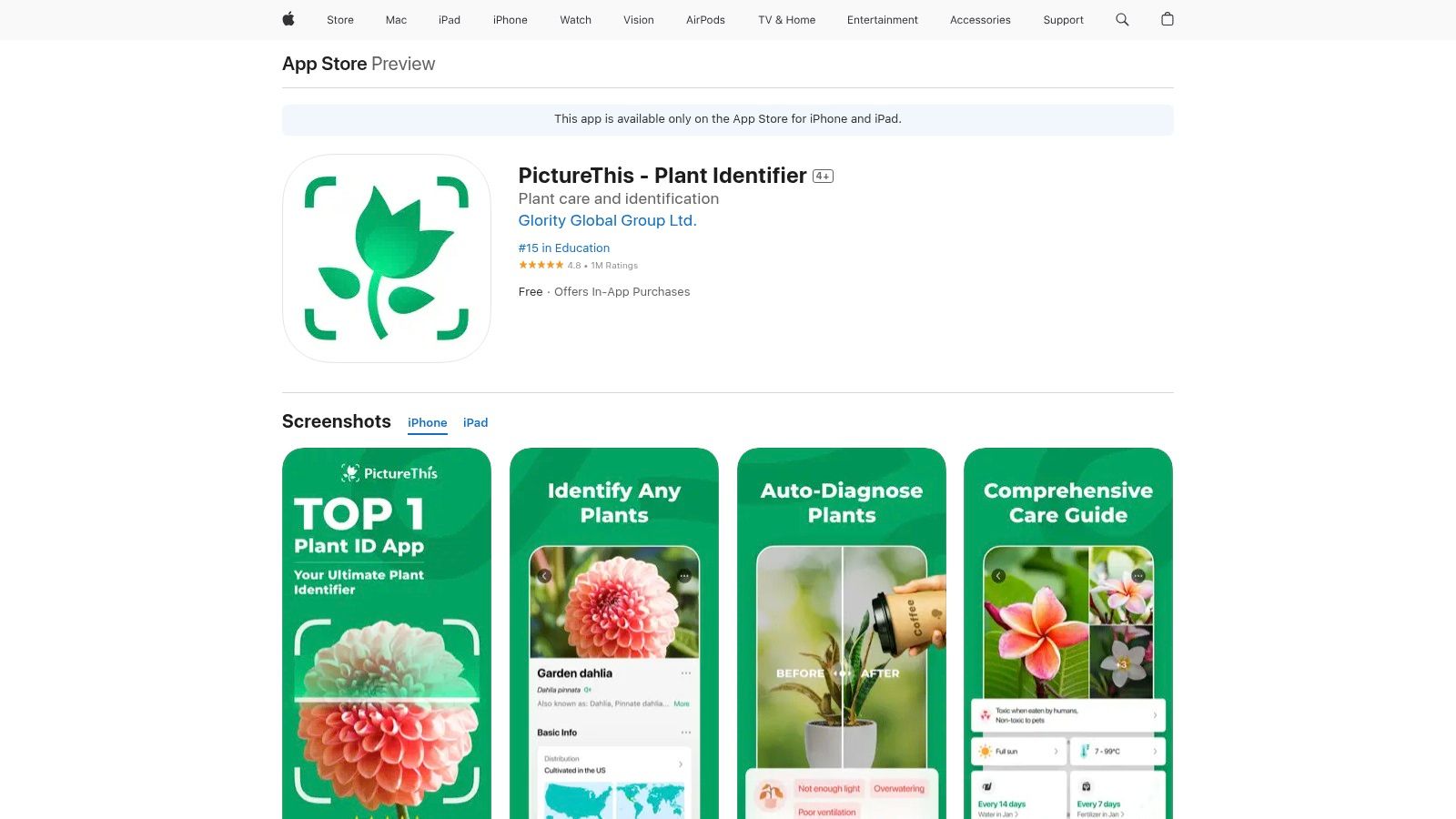
The app goes beyond simple naming by offering automated disease diagnosis, care calendars, and even a light meter tool to help you find the perfect spot for a new houseplant. Its "My Garden" feature allows you to save your plants and receive basic care reminders. The user experience is smooth and intuitive, designed to provide quick, visually appealing information for both new and experienced plant owners.
Why It Stands Out
What sets PictureThis apart in the free tier is the speed and polish of its AI identification combined with basic care advice. It bridges the gap between a pure identifier and a full management app, offering a taste of both. A good plant identification app can truly transform your garden by helping you understand every plant's needs.
Practical Use Case: Your new peony bush has developed strange spots on its leaves. You snap a photo and upload it to PictureThis. The app quickly suggests it might be a fungal issue like botrytis blight and offers initial management tips, helping you address the problem before it spreads.
Best For: Gardeners who want a fast, user-friendly tool for quick identification of common landscape plants, houseplants, and associated diseases.
Pros: Extremely fast and accurate AI for identification, polished and intuitive user interface, and combines plant ID with basic care and disease diagnosis.
Cons: The free version has limitations and frequent prompts to upgrade; many of the most useful features like unlimited IDs and detailed care guides are behind a subscription paywall.
Access: https://apps.apple.com/us/app/picturethis-plant-identifier/id1252497129
10. PlantSnap
PlantSnap positions itself as a powerful, pocket-sized botanist, making it a strong contender among the best free gardening apps for on-the-go plant identification. It leverages a massive database of over 600,000 species to provide instant IDs from a single photo. For gardeners, this is incredibly useful when visiting a nursery, admiring a neighbor's yard, or simply trying to identify a plant that has sprouted in your garden.
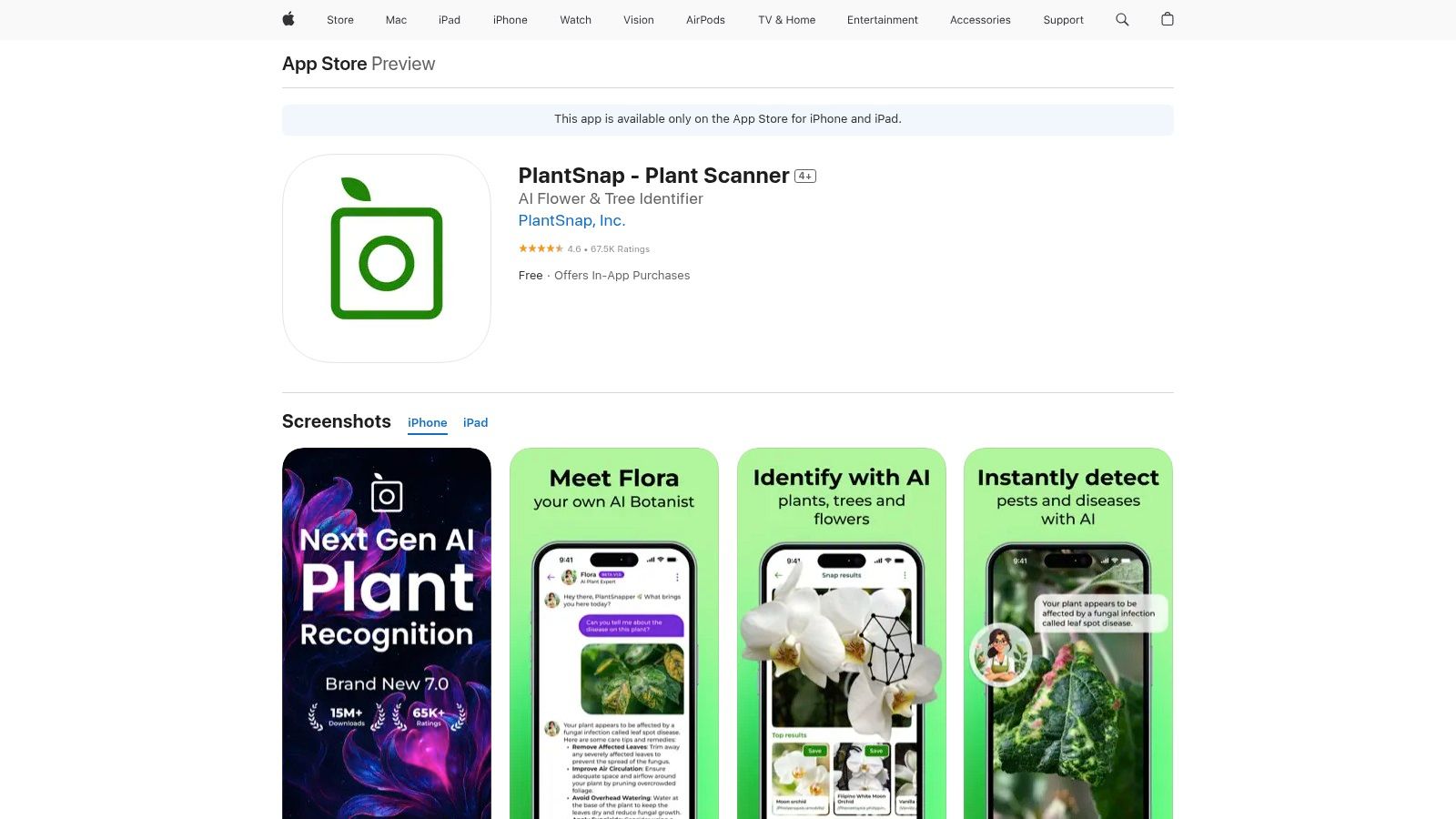
The app's workflow is straightforward: you snap a picture, and its AI technology analyzes the image to offer an identification, often accompanied by basic care information. Beyond simple identification, PlantSnap fosters a sense of community and discovery through its "SnapMap" and explore feeds. These features allow you to see what plants are being identified by other users around the world, turning a simple utility into a global plant-spotting adventure.
Why It Stands Out
PlantSnap’s main appeal is its combination of a vast species database with social discovery features. While many apps offer identification, the SnapMap provides a unique way to explore local flora and see what’s thriving in your area, offering inspiration for your own garden. It transforms the task of identification into a more engaging, community-driven experience.
Practical Use Case: You're at a local garden center and see an unlabeled perennial with beautiful flowers you think would be perfect for your climate. Instead of searching online with vague descriptions, you use PlantSnap to get an instant identification, learn its scientific name, and find basic care requirements to decide if it’s a good fit for your yard.
Best For: Gardeners who enjoy discovering new plants, need quick IDs at nurseries or on walks, and appreciate a community-focused app.
Pros: Simple and fast workflow for identification, large user base, and fun discovery features like SnapMap and the Explore feed.
Cons: Identification accuracy can sometimes vary. Many advanced features and unlimited snaps are locked behind a premium subscription, and it lacks comprehensive garden management tools.
Access: https://apps.apple.com/us/app/plantsnap-plant-identifier/id1451054346
11. Planta
While many apps try to cover all aspects of gardening, Planta shines by focusing intensely on one thing: plant care routines. Primarily geared towards houseplant enthusiasts but useful for outdoor container gardeners, it functions as a personal assistant for your green friends. Its slick interface and powerful reminder system make it one of the most popular and best free gardening apps, especially for those who struggle with remembering when to water, fertilize, or repot.
The free version of Planta allows you to add your plants, get basic care information, and set manual reminders. The app's core strength lies in its ability to generate a personalized care schedule. You input your plant type, pot size, and location, and Planta builds a schedule for watering, fertilizing, misting, and cleaning. It also includes helpful tools like a light meter to assess the sunlight in your space and a plant identification feature.
Why It Stands Out
Planta’s polished user experience and robust notification system set it apart. It gamifies plant care with progress trackers and "snooze" functions for watering, making it feel less like a chore. The app is incredibly user-friendly, making it a fantastic entry point for beginner plant parents who feel overwhelmed.
Practical Use Case: You just bought your first Fiddle Leaf Fig (Ficus lyrata) and are nervous about its reputation for being finicky. You add it to Planta, use the light meter to find the perfect spot, and set up the recommended watering schedule. The app will now send you timely notifications, taking the guesswork out of its care. For more advanced troubleshooting, you can learn more about how to identify plant diseases and save your garden.
Best For: Houseplant collectors, new gardeners, and anyone needing a structured routine for their indoor or container plants.
Pros: Excellent, user-friendly interface. Strong focus on building consistent care habits. The free version is highly functional for basic needs.
Cons: Heavily focused on houseplants over outdoor gardening. Many of the most powerful features (like smart schedules and Dr. Planta) are behind a premium subscription.
Access: https://getplanta.com
12. Flora Incognita
Born from a university research project, Flora Incognita is a powerful, science-backed plant identification tool that is completely free and ad-free, easily earning its place among the best free gardening apps. This app uses artificial intelligence to rapidly identify plants from photos, with a strong focus on Central European wild flora, but its database is extensive enough to recognize thousands of species globally, including many common garden ornamentals.

The identification process is intuitive: you take photos of a plant’s flower, leaf, or fruit, and the app’s AI analyzes the images to provide a highly probable match. Each identification is accompanied by a detailed fact sheet covering the plant’s characteristics, distribution, and status. Your anonymous observations contribute to biodiversity research, making it another excellent citizen-science tool.
Why It Stands Out
Flora Incognita’s standout features are its commitment to being truly free, its research-backed accuracy, and its respect for user privacy. Unlike many commercial apps, it doesn’t push subscriptions or clutter the interface with ads. The offline functionality is also a major plus, allowing you to save observations in the field and identify them later.
Practical Use Case: You’re hiking near your home and spot a beautiful wildflower you’ve never seen before. You wonder if it would be suitable for the wild, native section of your garden. Using Flora Incognita, you can identify it on the spot (even without a cell signal), learn about its needs, and determine if it's a protected species before considering adding it to your landscape.
Best For: Gardeners interested in native European plants, hikers, students, and anyone wanting a scientifically robust, ad-free identification app.
Pros: Completely free with no ads or in-app purchases, high identification accuracy, and all usage contributes to scientific research.
Cons: Primarily focused on wild flora and may lack detailed information on specific garden cultivars. It is not a garden management tool.
Access: https://floraincognita.com
How to Choose the Right Gardening App For You
Navigating the digital landscape of gardening tools can feel as complex as understanding the soil food web. We've explored a dozen of the best free gardening apps, each offering a unique set of features designed to enhance your green-thumb skills. From the powerful, citizen-science-driven identification of iNaturalist to the dedicated garden planning prowess of Planter, there's a specialized tool for nearly every gardening task.
Your ideal app depends entirely on your goals. For instance, imagine Sarah from Portland, a new homeowner, wants to grow her own avocados but isn't sure which variety will survive the Pacific Northwest winters. A generic app might identify it as Persea americana but offer little else. This is where a specialized tool becomes critical.
From Information to Implementation: A Real-World Example
Sarah's problem is common: she has general information but needs specific, local wisdom. While an app like Planter could help her map out her garden, it won't tell her that a 'Fuerte' avocado might struggle while a 'Mexicola' could thrive in her specific microclimate.
This is where integrating data with community becomes a game-changer. Sarah could use an app like Tendra to not only access its extensive avocado cultivar database—comparing cold hardiness and maturation times—but also to connect with a "Twin Plant Mate" just a few miles away who has already successfully grown 'Mexicola' avocados. This local connection provides invaluable, practical advice that no generic database can match.
The key takeaway is to match the right digital tool to your personal gardening philosophy.
Are you a data-driven planner? You might gravitate towards
PlanterorFrom Seed to Spoon.Is community and sharing your passion? Look for strong social and local networking features.
Are you an explorer and identifier?
Seek,Pl@ntNet, andFlora Incognitaare your digital field guides.Is your focus on troubleshooting plant health?
PictureThisandGarden Answersare essential tools.
From Data to Wisdom: Your Next Step
Choosing your digital companion is the first step toward a more organized, informed, and successful gardening experience. While many of the best free gardening apps provide excellent data, the ultimate goal is to translate that data into real-world success by connecting with people who have solved the exact problems you face. This approach helps you spend less time worrying and more time with your hands in the dirt, connecting with your plants and the gardeners who love them.
Ready to bridge the gap between information and community? Tendra combines high-accuracy AI diagnostics and the world's most comprehensive cultivar databases with a thriving local network through its Twin Plant Mates™ feature. Discover local growing partners with Tendra - where local gardeners connect and thrive. Explore how Gaialab can transform your gardening journey today.
